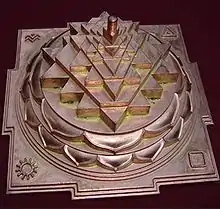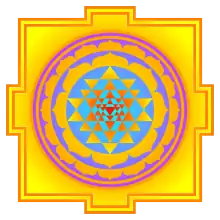Shri Vidya
Shri Vidya (ISO: Śrī Vidyā; lit. ''knowledge', 'learning', 'lore', or 'science'';[1] sometimes also spelled Sri Vidya or Shree Vidya) is a Hindu Tantric religious system devoted to the Goddess as Lalitā Tripurasundarī (Beautiful Goddess of the Three worlds), Bhuvaneshvari, Maha Lakshmi, etc. A thousand names for this form of Devī are recited in the Lalitā Sahasranāma, which includes Śrī Vidyā concepts.[2] The sect accepts and aims to provide both material prosperity and self-realisation. It has an extensive literature.[3] Details of belief vary in different texts but the general principles are similar to those found in Kashmir Shaivism.[4] Although Shri Vidya is completely against Adi Shankara's Advaita philosophy, in some parts of India, it is believed to be originated from him.

| Part of a series on |
| Shaktism |
|---|
 |
|
|
In the principally Shakta theology of Śrī Vidyā the goddess is supreme, transcending the cosmos that is her manifestation.[5] She is worshiped in the form of a mystical diagram (Sanskrit: yantra), a central focus and ritual object composed of nine intersecting triangles, called the Shri Yantra or Śrī Cakra[6] The Meru Chakra is a three-dimensional form of this, made of rock crystal or metal, often a traditional alloy of silver, antimony, copper, zinc and pewter that is held to enhance the flow and generation of its beneficial energies, covered in gold.
Mantras are believed to reveal the unity of the deity, the guru and initiate and the mantra or sound syllable Itself. The first mantra given to initiates is the Bala Tripurasundari Mantra. Here the Goddess is visualized as a small child. The next level mantra is the fifteen-lettered Panchadasi or Panchadasakshari Mantra. A higher mantra is the sixteen-lettered Shodasi or Shodashakshari.
Some of the people who promoted the knowledge of Shri Vidya include Sri Amritananda Natha Saraswati of Devipuram and Guru Karunamaya of Soundarya Lahari Trust in India.
Major texts
- Sarada Tilaka
- Parashurama kalpasutra
- Prapanchasara
- Soundarya Lahari
- Tripura Rahasya
- Shri vidya sutrani of Mahapujya Shri Devinatha
- Shodashi kramadi of Mahapujya Shri Devinatha
- Dasamaha vidya sutrani of Ganapati muni.
- Udbhodana saptati of Yagnesha.
- Bhavanopanishad.
- Vamakeshwara tantra.
Notes
- Apte 1965, p. 857.
- For influence on the Lalitā Sahasranāma and a brief summary of some Śrī Vidyā practices see: Sastry 1986, pp. vii–ix.
- Bhattacharyya 1999, p. 329.
- Flood 1996, p. 188.
- For goddess as supreme and beyond the manifest cosmos, see: Flood 1996, p. 188.
- Flood 1996, pp. 187–188.
References
- Apte, Vaman Shivram (1965), The Practical Sanskrit Dictionary (Fourth revised and enlarged ed.), Delhi: Motilal Banarsidass Publishers, ISBN 81-208-0567-4
- Bhattacharyya, N. N. (1999), History of the Tantric Religion (Second revised ed.), New Delhi: Manohar, ISBN 81-7304-025-7
- Dempsey, Corinne G. (2006), The Goddess Lives in Upstate New York: Breaking Convention and Making Home at a North American Hindu Temple (first ed.), New York: Oxford University Press, ISBN 978-0-19-518729-8
- Dev, K. V., ed. (1996), The Thousand Names of the Divine Mother, San Ramon, California: Mata Amritanandamayi Center, ISBN 1-879410-67-2
- Flood, Gavin (1996), An Introduction to Hinduism, Cambridge: Cambridge University Press, ISBN 0-521-43878-0
- Joshi, L. M. (1998), Lalitā Sahasranāma, New Delhi: D. K. Printworld (P) Ltd., ISBN 81-246-0073-2
- Sastry, R. Ananthakrishna (1986), Lalitāsahasranāma, Delhi: Gian Publishing House
- Tapasyananda, Swami (1990), Śrī Lalitā Sahasranāma, Mylapore, Chennai: Sri Ramakrishna Math, ISBN 81-7120-104-0
- Melanathuru, Venkata Subrahmanyam, Śhrī Vidya Upasana, Nellore, Andhra Pradesh - 9849120534
{{citation}}: CS1 maint: location (link)
